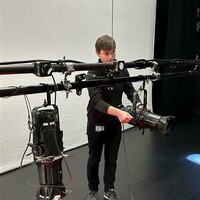21 May: Giulia Roversi & muZo Dance Theatre Company/Joshua Harriette / Stephanie D. Handjiiska & Elena Marinova

News Story
Giulia Roversi & muZo Dance Theatre Company WALLPAPER
Joshie Harriette (Lab_13) The Lite of Spring
Stephanie D. Handjiiska & Elena Marinova 84 Dials
In muted light two performers move with an explorative curiosity, both towards their bodies and each other. One, with light bulbs attached to her limbs, falls among a heap of torn newspaper; the other begins to dress herself with the scattered pieces. It is a strong opening image to Giulia Roversi & muZo Dance Theatre Company’s WALLPAPER, yet it is quickly left behind. Too often in this work, the strongest moments become one of many disparate images in a piece packed full of ideas. There are solo moments among the cast of eight that are expressive in their physicality, the choreography precise and articulate. WALLPAPER holds potential, it simply throws too much into 25 minutes to be clear in its intention.
A choreography of light, Joshua Harriette’s The Lite of Spring feels like a meditation on the intricacies of Stravinksy’s score. Block colours flash rhythmically across a heap of lighting grids picking out the jagged strings, while a morphing ring of projected light catches at the softer, trilling melodies. As the work builds, different lights begin to adopt their own personas - searching, menacing, frantic - dancing a journey through Stravinsky's iconic work towards its inevitable red-washed conclusion. Some moments work better than others, but it’s an enjoyably mesmeric experience.
Stephanie D. Handjiiska & Elena Marinova’s 84 Dials offers an entertaining close to the evening. Taking a satirical approach to the worth of their art form, the duo ask their audience to bid on the dances they perform. Value their work high enough and you get to watch, too low and it’s time to pop on the eye mask provided - as they point out, listening is free. Playfully questioning notions of capitalism and market values, 84 dials is both fun and serious. The anecdotes behind each short dance share an insight into the personal cost of artistry, yet the duo’s over-performative presentation remains tongue-in-cheek upbeat. Given that polished framework, the piece would benefit from a more slick delivery of its content and there is space for refinement to the script and choreography. However, regardless of whether you dutifully play the game or peek at their dances, it is the value of the concept that matters here.
Rachel Elderkin
Haunted by the habitual expectations of domestic settings and chores, Giulia Roversi & muZo Dance Theatre Company's WALLPAPER provides insight into the complex process of aligning gendered rituals with cerebral desires. Exploring the different subjective impulses that are triggered by household objects, the relationship between women and their domestic settings is often pulled in contradictory directions. Seductively calm and somehow classically informed constellations of group movement are juxtaposed with edgy solo performances. On closer examination, the energy of these lone dancers provides subtle insight into the hysteric impulses that arise when one fails to fall in line with the exhilarating rituals being consumed by the pack.
In Joshua Harriette's The Light of Spring, light and its movements are a choreographic approach that can radically expand the possibilities of dance. The artistic pallet of this work is built around Igor Stravinsky’s classic ballet and orchestral composition The Rite of Spring. Unhinging this work from its historic roots, The Light of Spring innovatively incorporates light, movement and rhythm to transport its audiences to the distant and unearthly atmospheres of a new dance world. The moments of the performance that were the most exhilarating were those that opened and closed the performance. This organic beam of white light emerging from a black background, and the tower of red heartbeats that pulsated from the centre of the stage were brilliant pieces of stillness that stilled and instilled in us a new dimension.
An ambitious experiment in audience engagement Stephanie D. Handjiiska & Elena Marinova’s 84 Dials asked spectators to rank descriptions of performances against a dance ‘payment sheet’ of roses. Those who offered an adequate sum were allowed to watch, while those who did not had to listen, blindfolded. Although the performances the audience ‘paid’ to watch weren’t always oozing with the seductive force and immaculately timed cues used by the capitalist market, the work succeeded in luring its crowd to think about dance and its value. By physically inhabiting the roles of both spectator and dance judge, audiences were allowed an active viewing experience that encouraged a deep consideration of the value of how something is marketed compared to how it is lived and perceived.
Sarah-Mace Dennis


